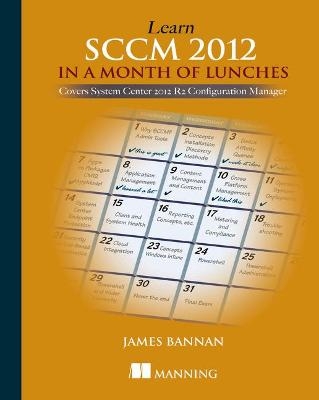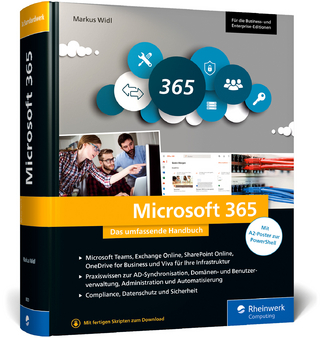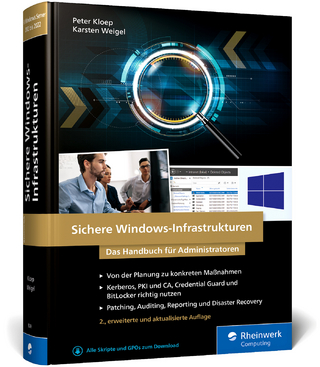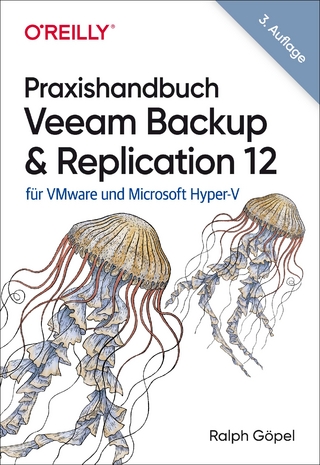
Learn SCCM 2012
Manning Publications (Verlag)
978-1-61729-168-5 (ISBN)
The single most useful consolidated source of SCCM guidance I’ve found.Francis Setash, US Department of State.
- Covers all aspects of SCCM administration
- Discusses brand-new SCCM management concepts Shows how to deploy applications from the cloud
Readers need no prior experience with System Center Configuration Manager.
Most businesses rely on a complex patchwork of client computers, physical and virtual servers, middleware, and, increasingly, mobile devices and cloud services.
Microsoft System Center Configuration Manager (SCCM) sits smack in the middle of this tapestry, providing a single administrative control center to deploy and manage Windows servers and applications across your entire infrastructure, including cross-platform management of Mac OS X, Linux, and UNIX.
Learn SCCM in a Month of Lunches is a super-practical guide to Microsoft System Center Configuration Manager. This book cuts to the chase and gets readers up to speed with the day-to-day tasks of managing a system with SCCM in a matter of days.
Whether readers have just been pressed into service as new sysadmin or are familiar with the inner workings of Active Directory and App-V, they'll be productive immediately as they work through the 25 self-contained lessons in this handy tutorial.
Configuration Manager is one of the flagship products in Microsoft's System Center 2012 suite. It enables businesses to effectively deploy and manage Windows systems and applications across their entire environment.
James Bannan is a Technology Evangelist with Dilignet, a Microsoft Gold Partner based in Australia, and specializing in the Microsoft System Center suite. James has presented on Configuration Manager at multiple Microsoft TechEd events and holds a Microsoft Most Valuable Professional (MVP) award in Enterprise Client Management.
1. Before You Begin
1.1. Why Configuration Manager?
1.2. Is this book for you?
1.3. How to use this book
1.3.1. The main chapters
1.3.2. Try It Now sections
1.3.3. Above & Beyond sidebars
1.3.4. Working with PowerShell
1.3.5. Labs
1.3.6. Further exploration
1.3.7. Which Log? sections
1.4. Setting up your lab environment
1.5. Online resources
1.6. Being immediately effective with ConfigMgr 2012 R2
2. Setting up your lab environment
2.1. Create the virtual environment
2.2. Download the prerequisite software
2.2.1. SysinternalsBGInfo
2.2.2. Microsoft Deployment Toolkit (MDT) 2013
2.2.3. Microsoft Assessment and Deployment Kit (ADK) for Windows 10
2.2.4. Microsoft SQL Server 2012 SP1
2.2.5. Windows Server 2012
2.2.6. Windows 10 Enterprise x64
2.2.7. System Center 2012 Configuration Manager R2
2.2.8. System Center 2012 Configuration Manager R2 Prerequisites
2.2.9. Hydration Script Package
2.3. Install and configure MDT 2013
2.3.1. Populate MDT with all the prerequisite software
2.3.2. Use MDT to generate an automated build image (ISO)
2.4. Build the Virtual Machines
2.4.1. LAB-DC01
2.4.2. LAB-CM01
2.4.3. LAB-CLIENT01
2.5. Verify the ConfigMgr installation
3. Making ConfigMgr aware of your environment
3.1. Discovery concepts
3.1.1. Looking at log files
3.2. Discovery methods
3.2.1. Active Directory Forest Discovery
3.2.2. Active Directory System Discovery
3.2.3. Active Directory User Discovery
3.2.4. Active Directory Group Discovery
3.3. Boundaries
3.3.1. Creatinga boundary
3.3.2. Creating a boundary group
3.3.3. Linking the boundary group with Configuration Manager
3.4. Lab
3.5. Ideas for on your own
3.5.1. Controversy over boundaries
4. Managing ConfigMgr Devices and Users
4.1. Understanding Devices and the ConfigMgr client
4.1.1. Installing the ConfigMgr client on remote systems
4.2. Preparing for Client Push
4.2.1. Set the Client Push account permissions
4.2.2. Open the Windows Firewall
4.2.3. Configure the Client Push account
4.3. Perform a Client Push
4.4. Users in the ConfigMgr world
4.5. Creating relationships between Users and Devices
4.5.1. UDA scenario
4.5.2. Creating UDA relationships
4.6. Lab
4.6.1. Discover DC01
4.6.2. Disable the Windows Firewall on DC01
4.6.3. Push the ConfigMgr client to DC01
5. Organizing Devices and Users
5.1. Collection Concepts
5.1.1. Collection Membership
5.1.2. Collection Limiting
5.2. Creating a new Collection
5.2.1. Creating a new Device Collection
5.2.2. Creating a new User Collection
5.3. Understanding Windows Query Language
5.3.1. Creating a basic query
5.3.2. Using multiple attributes
5.3.3. Querying multiple sources
5.3.4. Combining data from multiple sources
5.4. Managing Collections
5.4.1. Use folders
5.4.2. Be aware of Collection updating
5.4.3. Moving Collections between hierarchies
5.5. Lab
5.6. Ideas for on your own
6. Configuring ConfigMgr clients
6.1. Exploring client settings
6.1.1. Default client settings
6.1.2. When to change the default client settings
6.1.3. Changing the default client settings
6.2. Creating custom Settings
6.2.1. Create custom Device settings
6.2.2. Create custom User settings
6.3. Deploying custom settings
6.3.1. Deploying Device Settings
6.3.2. Deploying User Settings
6.3.3. Verify deployed settings
6.4. Forcing policy updates
6.4.1. Forcing a policy update via a local client
6.4.2. Forcing a policy update remotely via a console
6.5. Lab
7. Creating and Configuring Applications using the AppModel
7.1. Overview of ConfigMgr 2012 AppModel
7.1.1. ConfigMgr 2012 vs. ConfigMgr 2007
7.1.2. Applications vs Packages
7.2. Creating an ConfigMgr 2012 Application
7.2.1. Preparing the Application Source
7.2.2. Create Your Application
7.3. Configuring Your Application
7.3.1. Deployment Types
7.3.2. Requirements
7.3.3. Detection Methods
7.4. Lab
8. Deploying Applications & Packages to ConfigMgr clients
8.1. Deploying Applications
8.2. Deploying Applications to Devices
8.2.1. Step One: Distributing Application content
8.2.2. Step Two: Deploying the application to a Device Collection
8.2.3. Step Three: Installing an Application on a Device
8.3. Deploying Applications to Users
8.3.1. Installing the Application Catalog
8.4. Creating and Deploying Packages
8.4.1. Creating a Package
8.4.2. Deploying a Package
8.5. Turning Packages into Applications
8.6. Labs
9. Ensuring that ConfigMgr clients can access content
9.1. Distribution Points
9.2. Distributing Content
9.3. Distribution Point Groups
9.4. Keeping Content Healthy
9.4.1. Validate an individual package
9.4.2. Automating content validation
9.4.3. Spotting validation errors
9.5. Lab
9.6. Ideas for on your own
10. Keeping ConfigMgr Clients Patched
10.1. Install the Software Update Point
10.1.1. Install WSUS prerequisites
10.1.2. Install and configure WSUS
10.1.3. Install post-WSUS hotfix
10.1.4. Install the software update point
10.2. Configure Software Updates in ConfigMgr
10.3. Download Updates into ConfigMgr
10.4. Deploy Updates to ConfigMgr Clients
10.5. Lab
11. Preparing to deploy Windows
11.1. Importing an Operating System Image
11.2. Starting your deployment with WinPE
11.3. Handling different hardware platforms
11.4. Creating a new task sequence
11.5. Lab
12. Deploying Windows
12.1. Creating a new client system
12.2. Preparing for network booting
12.3. Customizing the Deployment Task Sequence
12.3.1. Customizing disk partitions
12.3.2. Specifying TS variables
12.3.3. Applying device drivers
12.4. Deploying Windows
12.4.1. Making content available from Windows PE
12.4.2. Deploying the Task Sequence
12.4.3. Installing Windows
12.5. Lab
12.6. Ideas for on Your Own
13. Advanced Deployment of Windows with ConfigMgr and MDT
13.1. Integrating MDT with ConfigMgr
13.1.1. Installing MDT
13.1.2. Building MDT packages within ConfigMgr
13.2. Making sure that MDT is awesome
13.2.1. Verifying MDT packages
13.2.2. Exploring MDT functionality
13.3. Lab
14. Managing Linux clients
14.1. Installing an Ubuntu server
14.2. Installing the ConfigMgr client for Linux
14.3. Navigating ConfigMgr for Linux
14.3.1. Connecting to Ubuntu remotely
14.3.2. ConfigMgr logs for Linux
14.4. Lab
15. Deploying to Linux and Mac clients
15.1. Working with Linux clients
15.1.1. Working with the Linux client
15.1.2. Inventorying Linux systems
15.1.3. Deploying Linux packages
15.2. Working with Mac OS X
15.2.1. Introducing Internet-Based Client Management
15.2.2. Installing the OS X client
15.2.3. Deploying OS X Applications
16. Managing antimalware with ConfigMgr
16.1. Enabling System Center Endpoint Protection
16.1.1. Configuring Software Updates
16.1.2. Endpoint Protection Server Role
16.1.3. Endpoint Protection on Clients
16.2. Using Antimalware Policies
16.3. Dealing with Malware outbreaks
16.4. Labs
17. Making sure clients are healthy
17.1. Understanding Common Client Health Issues
17.2. Administering Client Health
17.2.1. Active Clients
17.2.2. Inactive Clients
17.3. Using Client Center for Configuration Manager
17.3.1. Monitoring
17.3.2. Inventory
17.3.3. Software Distribution
17.3.4. Agent Settings
17.4. Labs
18. Reporting in Configuration Manager
18.1. Enabling Reporting Services
18.2. Executing Reports
18.3. Subscribing to Reports
18.4. Building Custom Reports
18.5. Labs
19. Keeping an eye on your Clients
19.1. Enabling Software Metering
19.2. Configuring Compliance
19.2.1. Configuration Items
19.2.2. Configuration Baselines
19.3. Compliance in action
19.4. Labs
20. What to do when things go wrong
20.1. Assessing Site Health
20.2. Common Environmental Issues
20.2.1. Disk Space
20.2.2. Active Directory
20.2.3. DNS
20.2.4. Admin Rights
20.2.5. Internet Access
20.3. Labs
21. Securing Configuration Manager
21.1. Administrative Users
21.2. Security Roles
21.3. Security Scopes
21.4. Granular permissions
21.5. Labs
22. All Engines Full Ahead
22.1. Advanced ConfigMgr projects
22.1.1. More infrastructure
22.1.2. Use HTTPS
22.1.3. Go to the cloud
22.1.4. Take control of your database
22.1.5. Advanced client configuration
22.2. Learn from the community
| Erscheint lt. Verlag | 4.8.2016 |
|---|---|
| Verlagsort | New York |
| Sprache | englisch |
| Maße | 185 x 234 mm |
| Gewicht | 1000 g |
| Einbandart | kartoniert |
| Themenwelt | Informatik ► Betriebssysteme / Server ► Windows Server |
| Mathematik / Informatik ► Informatik ► Netzwerke | |
| Mathematik / Informatik ► Informatik ► Software Entwicklung | |
| Schlagworte | Microsoft SQL Server 2012 • Microsoft System Center Configuration Manager 2012 • Windows 10 • Windows Server 2012 |
| ISBN-10 | 1-61729-168-4 / 1617291684 |
| ISBN-13 | 978-1-61729-168-5 / 9781617291685 |
| Zustand | Neuware |
| Haben Sie eine Frage zum Produkt? |
aus dem Bereich


